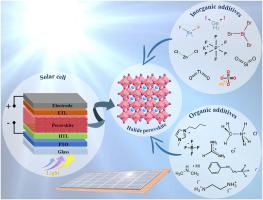Unveiling the potential of additives in optimizing halide perovskite solar cells performance and reliability
IF 7.1
3区 材料科学
Q1 GREEN & SUSTAINABLE SCIENCE & TECHNOLOGY
引用次数: 0
Abstract
This overview delves into the crucial role of additives in bolstering the performance and robustness of Halide Perovskite Solar Cells (PSCs). Categorizing both organic and inorganic additives, the study explores their substantial impact on enhancing the thermal and UV-light stability of PSCs. Various strategies such as solvent manipulation, doping, alloying, and nucleation control are discussed for optimizing the stability of PSCs. Additionally, focusing on improving hole and electron transporting layers, interface protections, and energy band configurations aids in augmenting the efficiency of PSCs. The employment of carbon electrodes and encapsulation techniques emerges as effective methods to bolster thermal stability in PSCs. Furthermore, a profound understanding of defect properties and interface materials is pivotal for augmenting the stability and durability of PSCs. The review encapsulates experimental methods, characterization techniques, and underlying mechanisms behind the additive-induced enhancements in PSCs. Moreover, the article addresses the challenges and future directions in utilizing inorganic additives to elevate the efficiency and stability of PSCs, providing a comprehensive overview of the current state of research and proposing avenues for further advancements in the realm of inorganic additives for Halide Perovskite Solar Cells.

揭示添加剂在优化卤化物过氧化物太阳能电池性能和可靠性方面的潜力
本综述深入探讨了添加剂在提高卤化物包光体太阳能电池(PSCs)的性能和稳健性方面的关键作用。研究将有机和无机添加剂分类,探讨它们对提高 PSC 热稳定性和紫外线稳定性的重大影响。研究讨论了优化 PSCs 稳定性的各种策略,如溶剂处理、掺杂、合金化和成核控制。此外,专注于改进空穴和电子传输层、界面保护和能带配置有助于提高 PSCs 的效率。采用碳电极和封装技术是提高 PSC 热稳定性的有效方法。此外,深入了解缺陷特性和界面材料对于提高 PSCs 的稳定性和耐用性至关重要。这篇综述囊括了实验方法、表征技术以及添加剂增强 PSCs 性能背后的基本机制。此外,文章还探讨了利用无机添加剂提高 PSCs 效率和稳定性所面临的挑战和未来发展方向,全面概述了研究现状,并提出了进一步推动卤化物包光体太阳能电池无机添加剂领域发展的途径。
本文章由计算机程序翻译,如有差异,请以英文原文为准。
求助全文
约1分钟内获得全文
求助全文
来源期刊

Materials Today Sustainability
Multiple-
CiteScore
5.80
自引率
6.40%
发文量
174
审稿时长
32 days
期刊介绍:
Materials Today Sustainability is a multi-disciplinary journal covering all aspects of sustainability through materials science.
With a rapidly increasing population with growing demands, materials science has emerged as a critical discipline toward protecting of the environment and ensuring the long term survival of future generations.
 求助内容:
求助内容: 应助结果提醒方式:
应助结果提醒方式:


